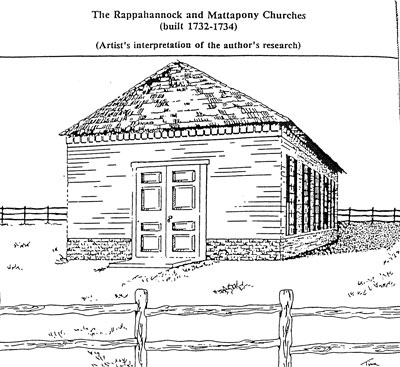The first parish church was designated to be at Germanna, the home of Alexander Spotswood. To accommodate the arriving settlers, the first vestry ordered two small frame churches built in 1724 in the eastern part of the county.

In 1732, the vestry began planning to relocate the northern church on a site awarded by the trustees of the village of Fredericksburg. In 1734, this church became the place of worship for the parishioners in the northern part of the country.
The small frame building remained in use for more than 80 years, until 1815. Among its vestrymen were Charles Washington, Fielding Lewis, Charles Lewis, Lewis Willis, George Thornton, Francis Thornton, and John Lewis, all of whom were related to George Washington. In addition, he had many friends and acquaintances among the other vestry mem bers – Charles Dick, Robert Jackson, Mann Page, Charles Mortimer, and Charles Yates, all prominent members of the Fredericksburg community.
George Washington himself had moved to the area as a boy of six when his father purchased the Ferry Farm in 1738. He never became a member of St. George’s parish for he did not reside in Spotsylvania County. But he was a frequent visitor to the town throughout his life, and in his diary, he recorded attendance at the Fredericksburg church on at least two occasions – in August. 1770, and June 1788.
At the time of the 1770 visit, his brother-in-law Fielding Lewis was serving as senior churchwarden, the highest lay position in the parish; his brother Charles and cousin Francis Thornton were vestry members.
On Aug 3, he wrote “Dined at my Brother Charles’s–spent the Evening there & lodgd at Colo. Lew(is).” The notes in his diary say that Charles owned 759 acres of land in the county outside of Fredrericksburg. Aug 1761 he had bought lots 87 and 88 from Warner Lewis of Gloucester which included the Rising Sun Tavern which according to popular tradition Charles Washington built and operated
He wrote on “August 5 “Went to Church (in Fredg.) and dind with Colo. Lewis.” He would have heard James Marye Jr (1731-1780) who had succeed his father as rector.
In 1772, George purchased a house in Fredericksburg for his mother so she could be closer to her daughter Betty.Mary Washington was sixty-four years old and a house in town meant her needs could be looked after. She would live there until her death in 1789.
He writes in June 1788, “The day following (Friday) we dined in a large Company at Mansfield (Mr. Man Page’s). On Saturday we visited Genl. Spotswoods dined there & returned in the Evening to My Sisters. ‘
During the 1788 visit, the church became so crowded — because of the returning hero’s presence — that the congregation panicked. He picks up the story – “On Sunday we went to Church. The Congregation being alarmed (without cause) and supposg. the Gallery at the No. End was about to fall, were thrown into the utmost confusion; and in the precipitate retreat to the doors many got hurt.” John Goolrick in his book Historic Fredericksburg: The Story of an Old Town maintains the crowd heard the sound of “creaking timbers.” He said they were only new rafters which needed proper adjustment.
The ministers who served the Fredericksburg colonial church were James Marye (1735-1767) and his son James Marye, Jr. (1768-1780). It is very likely that George Washington attended a school operated by the elder Marye on Princess Anne Street for a term or two some time before his sixteenth birthday.
In 1776, the new Virginia government suspended the salaries of all Anglican clergymen and exempted dissenters from supporting the church. The vestry, however, was still charged with the responsibility for the welfare of the residents of the parish. In spite of rampant inflation and a high turnover among its members, the vestry met each year during the war in private homes or ordinaries, and made welfare payments to the poor.
Our current church contains a stained glass window in the memory of Mary Ball Washington, donated by the Daughters of the American Revolution in 1907.
